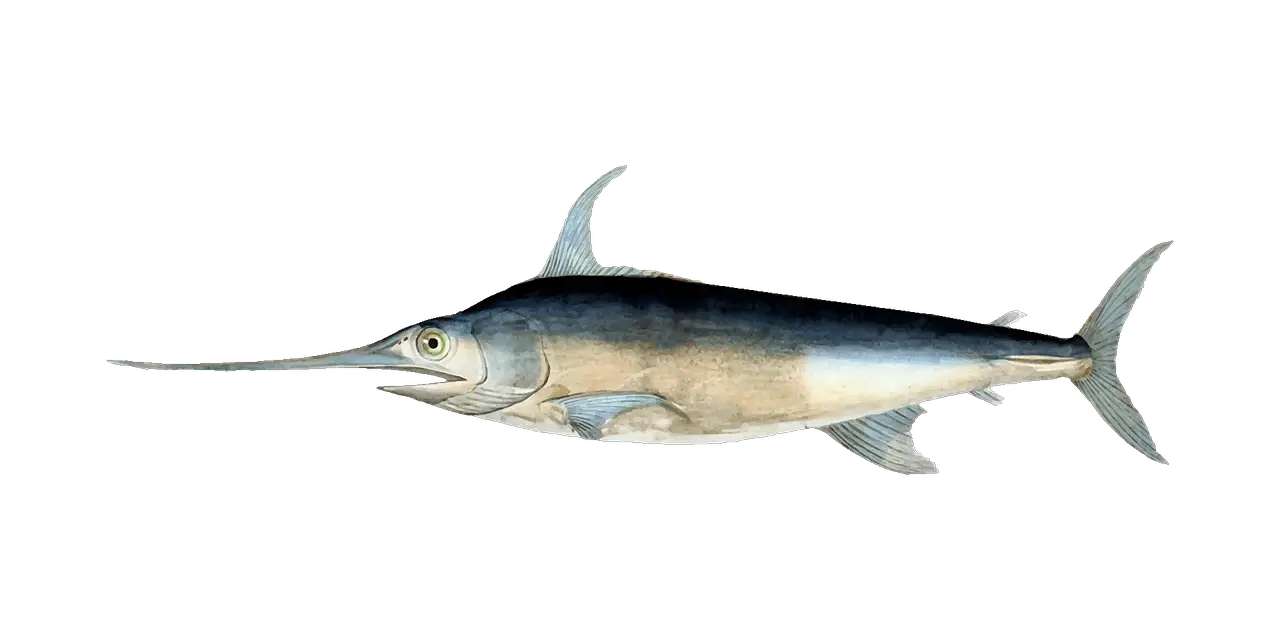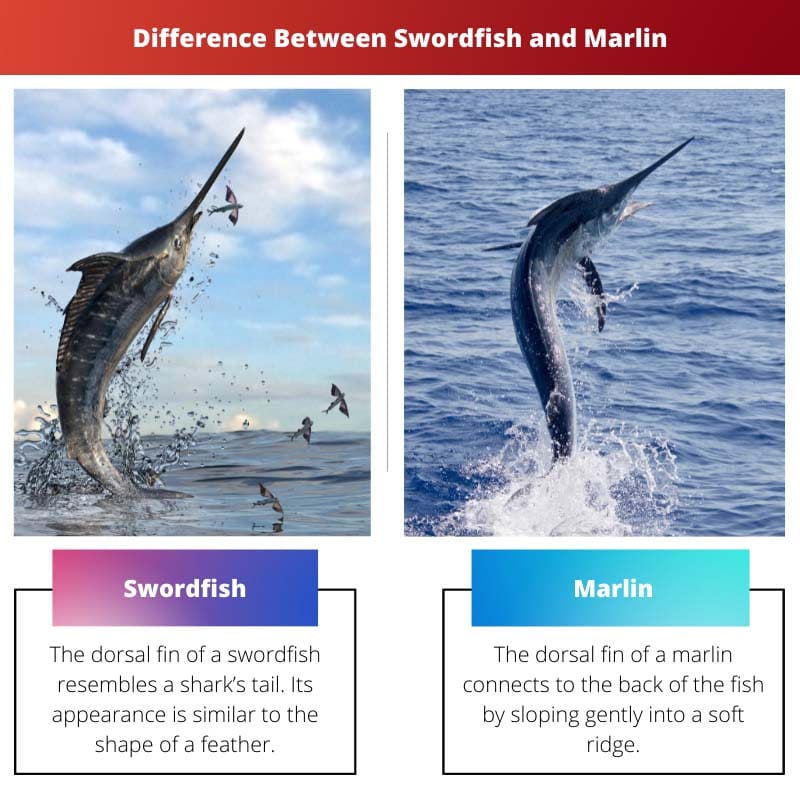Swordfish possess a longer, flattened sword-like bill, allowing them to slash through prey with precision and speed, while marlin, with their spear-like bills, are renowned for their agility and acrobatic leaps, challenging anglers with their powerful runs and aerial displays, creating an exhilarating battle between human and fish.
Key Takeaways
- Swordfish and Marlin are two types of large, predatory fish found in oceans worldwide.
- Swordfish have a long, flat bill and are known for their impressive speed and agility, while Marlin has a more pointed bill and is more prominent.
- While fishermen prize both fish for their sport and culinary value, they have distinct physical and behavioral differences that set them apart.
Difference Between Swordfish and Marlin
The difference between swordfish and marlin is that the dorsal fin of a swordfish bears a close resemblance to a shark’s tail, while the single dorsal fin of a marlin tapers down into a low ridge along the body of the fish. Swordfish bears a distinctive feather-like appearance, while marlin’s dorsal fin lacks such distinction.

Comparison Table for Swordfish vs Marlin
Swordfish vs. Marlin
| Feature | Swordfish | Marlin |
|---|---|---|
| Family | Xiphiidae (sole member) | Istiophoridae (several species) |
| Appearance | Long, rounded body with a pointed “bill” (rostrum) | Elongated, slender body with a long, pointed dorsal fin |
| Size | Up to 14 feet (4.3 meters) long, up to 1,400 lbs (635 kg) | Up to 16.4 feet (5 meters) long, up to 1,985 lbs (900 kg) |
| Habitat | Open ocean, near surface at night, deeper during day | Open ocean, surface and mid-waters |
| Diet | Smaller fish, squid | Smaller fish, squid, crustaceans |
| Hunting technique | Uses sword-like bill to slash and stun prey | Uses bill to stab and impale prey |
| Commercial value | High, prized for its meat | High, prized for its meat and sport fishing |
| Distinguishing feature | Pointed “bill” (rostrum) and lack of scales | Long, pointed dorsal fin (referred to as a “sail”) and scales |
What is a Swordfish?
Swordfish, scientifically known as Xiphias gladius, is a large predatory fish characterized by its distinctive long, flattened bill resembling a sword. This species belongs to the family Xiphiidae and is highly prized both commercially and recreationally for its firm, flavorful flesh and challenging sport fishing qualities.
Physical Characteristics
Swordfish have a streamlined body, ranging in color from dark brown to grayish-blue on the upper parts and a silver-white underside. Their most prominent feature is their elongated bill, which can reach lengths of up to 3 meters (10 feet) in some individuals. This bill is used primarily for hunting, aiding in slashing and stunning prey.
Habitat and Distribution
Swordfish are found in temperate and tropical waters worldwide, inhabiting depths ranging from the surface down to around 2,000 meters (6,600 feet). They prefer warmer waters but can tolerate a wide range of temperatures. Swordfish are highly migratory, with populations moving seasonally to follow prey and suitable environmental conditions.
Behavior and Feeding Habits
These apex predators are highly skilled hunters, preying on a variety of fish and cephalopods including squid and smaller pelagic species. Swordfish are known for their remarkable speed and endurance, capable of swimming at speeds of up to 50 miles per hour (80 kilometers per hour) for short bursts. They hunt near the surface at night, using their keen eyesight to locate prey silhouetted against the moonlight.
Conservation Status
While swordfish populations are considered relatively stable globally, they face threats from overfishing, bycatch in fisheries targeting other species, and habitat degradation. Sustainable management practices, such as regulations on fishing quotas and gear modifications to reduce bycatch, are essential for ensuring the long-term viability of swordfish populations.

What is a Marlin?
Marlins are large, fast-swimming fish belonging to the family Istiophoridae, known for their sleek, powerful bodies and elongated, spear-like bills. They are highly sought after by anglers for their thrilling sport fishing qualities and are renowned for their impressive size, speed, and acrobatic leaps.
Physical Characteristics
Marlins have a streamlined body shape, tapering to a slender tail fin. They possess a long, pointed bill that is considerably longer in proportion to their body compared to other billfish species. This bill, known as a “sword” or “billfish,” is rigid and sharp-edged, enabling marlins to slash through schools of fish with remarkable precision. Marlins are brilliantly colored, with shades of blue, black, silver, and white, and may display distinctive vertical stripes along their bodies.
Habitat and Distribution
Marlins are found in tropical and subtropical waters around the world, preferring offshore environments near the surface, where they can hunt their prey. They inhabit both coastal and oceanic waters, congregating near underwater features such as seamounts, reefs, and current boundaries. Marlins undertake extensive migrations, following seasonal shifts in water temperature and the distribution of prey species.
Behavior and Feeding Habits
As apex predators, marlins are voracious hunters, preying on a variety of pelagic fish species, squid, and occasionally smaller billfish. They are known for their exceptional speed and agility, capable of swimming at speeds exceeding 60 miles per hour (97 kilometers per hour) in short bursts. Marlins hunt by sight, using their keen vision to locate prey near the ocean’s surface. When hunting, they may use their bill to stun or slash their prey before consuming it.
Conservation Status
Marlins face significant threats from overfishing, habitat degradation, and bycatch in commercial fishing operations. Some species, such as the Atlantic blue marlin, are listed as vulnerable or endangered by conservation organizations due to population declines. Sustainable management practices, including catch limits, habitat protection, and bycatch reduction measures, are crucial for conserving marlin populations and ensuring their long-term survival.

Main Differences Between Swordfish and Marlin
- Bill Shape:
- Swordfish have a long, flattened bill resembling a sword, while marlins have an elongated, pointed bill resembling a spear.
- Habitat Preference:
- Swordfish inhabit temperate and tropical waters worldwide, found in deeper offshore regions.
- Marlins are also found in tropical and subtropical waters but tend to prefer more offshore environments near the surface, frequently near underwater features like seamounts and reefs.
- Feeding Habits:
- Swordfish primarily feed on fish and cephalopods, hunting near the surface at night using their keen eyesight.
- Marlins are voracious predators, feeding on pelagic fish species, squid, and occasionally other billfish, hunting near the ocean’s surface and using their bill to stun or slash prey.
- Physical Appearance:
- Swordfish have a more robust body shape and a longer, flattened bill.
- Marlins have a sleeker body shape with a more elongated, pointed bill and are brilliantly colored with shades of blue, black, silver, and white.
- Speed and Agility:
- Swordfish are known for their remarkable speed and endurance, capable of short bursts of swimming up to 50 miles per hour.
- Marlins are exceptionally fast and agile swimmers, capable of reaching speeds exceeding 60 miles per hour in short bursts, displaying impressive acrobatic leaps when hooked by anglers.

Conclusion
Swordfish and marlin are both renowned types of billfish. Both these varieties of fish are found in the warm tropical marine waters.
Both have similar hunting techniques and diets. This confuses the general populace as they frequently fail to distinguish one from the other.
However, both have some very telling differences. The weight, length, speed, and taste of each variety are rather different when compared to the other.
The most striking difference is noted in terms of appearance. When examined closely, the appearance of a swordfish is quite different from a marlin.
A swordfish is elongated and round, with a flat long snout. A marlin, on the other hand, is tubular and cylindrical, with a round snout.
The dorsal fin of a swordfish is like a shark’s distinctive-looking tail, while a marlin has a tail that looks quite different. These differences might come in handy while selecting a suitable fish for a fancy preparation.
Nonetheless, one cannot easily distinguish between the two when they are cooked and served.



